Related Research Articles

Why We Fight is a series of seven propaganda films produced by the US Department of War from 1942 to 1945, during World War II. It was originally written for American soldiers to help them understand why the United States was involved in the war, but US President Franklin Roosevelt ordered distribution for public viewing.

The British Commonwealth Air Training Plan (BCATP), or Empire Air Training Scheme (EATS) often referred to as simply "The Plan", was a massive, joint military aircrew training program created by the United Kingdom, Canada, Australia and New Zealand, during the Second World War. BCATP remains one of the single largest aviation training programs in history and was responsible for training nearly half the pilots, navigators, bomb aimers, air gunners, wireless operators and flight engineers who served with the Royal Air Force (RAF), Royal Navy Fleet Air Arm (FAA), Royal Australian Air Force (RAAF), Royal Canadian Air Force (RCAF) and Royal New Zealand Air Force (RNZAF) during the war.
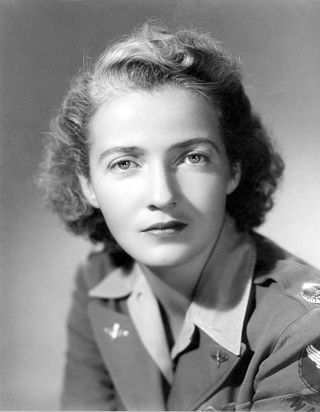
Nancy Harkness Love, born Hannah Lincoln Harkness, was an American pilot and airplane commander during World War II. She earned her pilot's license at age 16. She worked as a test pilot and air racer in the 1930s. During World War II she convinced Colonel William H. Tunner of the U.S. Army Air Forces to look to set up a group of female pilots to ferry aircraft from factories to air bases. This proposal was eventually approved as the Women's Auxiliary Ferrying Squadron. Love commanded this unit and later all ferrying operations in the newly formed Women Airforce Service Pilots. She was awarded the Air Medal for her work during the war and was appointed lieutenant colonel in the US Air Force Reserve in 1948.
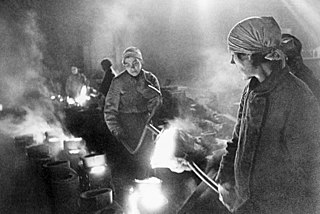
Military production during World War II was the production or mobilization of arms, ammunition, personnel and financing by the belligerents of the war, from the occupation of Austria in early 1938 to the surrender and occupation of Japan in late 1945.

Vance Air Force Base is a United States Air Force base located in southern Enid, Oklahoma, about 65 mi (105 km) north northwest of Oklahoma City. The base is named after local World War II hero and Medal of Honor recipient, Lieutenant Colonel Leon Robert Vance Jr.

Military gliders have been used by the militaries of various countries for carrying troops and heavy equipment to a combat zone, mainly during the Second World War. These engineless aircraft were towed into the air and most of the way to their target by military transport planes, e.g., C-47 Skytrain or Dakota, or bombers relegated to secondary activities, e.g., Short Stirling. Most military gliders do not soar, although there were attempts to build military sailplanes as well, such as the DFS 228.
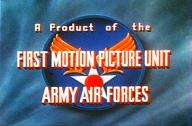
The 18th AAF Base Unit, originally known as the First Motion Picture Unit, Army Air Forces, was the primary film production unit of the U.S. Army Air Forces (AAF) during World War II, and was the first military unit made up entirely of professionals from the film industry. It produced more than 400 propaganda and training films, which were notable for being informative as well as entertaining. Films for which the unit is known include Resisting Enemy Interrogation, Memphis Belle: A Story of a Flying Fortress and The Last Bomb—all of which were released in theatres. Veteran actors such as Clark Gable, William Holden, Clayton Moore, Ronald Reagan, and DeForest Kelley, and directors such as John Sturges served with the 18th AAF Base Unit. The unit also produced training films and trained combat cameramen.

Air Force is a 1943 American World War II aviation film directed by Howard Hawks and starring John Garfield, John Ridgely, Gig Young, Arthur Kennedy, and Harry Carey. The film was distributed by Warner Bros. and produced by Hal B. Wallis and Jack L. Warner. Conceived by then - Lieutenant General “Hap” Arnold in the aftermath of the Pearl Harbor attack, it was originally scheduled for release on December 7, 1942, on the first anniversary. It became impossible to meet that deadline, and it premiered in New York City on February 3, 1943 and was released on March 20. The film's storyline revolves around an actual event that occurred on December 7, 1941. An aircrew ferries an unarmed 1940 series Boeing B-17D Flying Fortress heavy bomber, named the Mary-Ann, across the Pacific to the United States Army Air Forces base at Hickam Field. They fly right into the middle of the Japanese air attack on Pearl Harbor and the beginning of America's major involvement in the Second World War. An uncredited William Faulkner wrote the emotional deathbed scene for Ridgely, who played the commander and pilot of the Mary-Ann.

Flying Tigers is a 1942 American black-and-white war film drama from Republic Pictures that was produced by Edmund Grainger, directed by David Miller, and stars John Wayne, John Carroll, and Anna Lee.

The Battle of Midway is a 1942 American short documentary film directed by John Ford. It is a montage of color footage of the Battle of Midway with voice overs of various narrators, including Johnny Governali, Donald Crisp, Henry Fonda, and Jane Darwell.

Combat America is a 1945 documentary film produced in World War II, narrated by Clark Gable. At the time of the film's production in 1943, Gable was a 1st Lieutenant in the Eighth Air Force, part of the United States Army Air Forces. While he was stationed in England, Gable flew five combat missions from May 4–September 23, 1943, and during one of them, his boot was struck by an anti-aircraft shell, and he was nearly hit by other flak bursts. Gable's film crew included MGM cameraman Andrew J.McIntyre; 1st Lt. Howard Voss, a sound engineer; Master Sgt. Robert Boles, a cameraman; Master Sgt. Marlin Toti, another cameraman; and 1st Lt. John Mahlin, a scriptwriter."
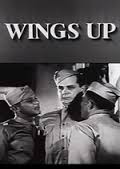
Wings Up is a short propaganda film produced during World War II, highlighting the role of the United States Army Air Forces Officer Candidate School. The film emphasized that while usually these courses would take up to a year in college, the country was at war now and needed all the qualified officers it could get and fast. The curriculum is briefly outlined in Wings Up as well as the kind of life a student would lead at this training center.
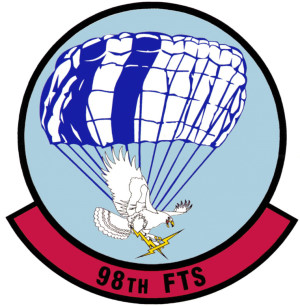
The 98th Flying Training Squadron is a United States Air Force unit assigned to the Air Education and Training Command 306th Flying Training Group. It is stationed at the United States Air Force Academy, Colorado, however the current UV-18 B Twin Otter aircraft are housed and maintained at nearby Peterson Air Force Base, Colorado.

Beyond the Line of Duty is a 1942 American short propaganda film, directed by Lewis Seiler. The documentary film reenacted the life and career of United States Army Air Corps Captain Hewitt T. "Shorty" Wheless.

The United States Army Air Forces was the major land-based aerial warfare service component of the United States Army and de facto aerial warfare service branch of the United States during and immediately after World War II (1941–1947). It was created on 20 June 1941 as successor to the previous United States Army Air Corps and is the direct predecessor of the United States Air Force, today one of the six armed forces of the United States. The AAF was a component of the United States Army, which on 2 March 1942 was divided functionally by executive order into three autonomous forces: the Army Ground Forces, the United States Army Services of Supply, and the Army Air Forces. Each of these forces had a commanding general who reported directly to the Army Chief of Staff.
World War II changed the possibilities for animation. Prior to the war, animation was mostly seen as a form of family entertainment. The attack on Pearl Harbor was a turning point in its utility. On December 8, 1941, the United States Army began working with Walt Disney at his studio, stationing Military personnel there for the duration of the war. The Army and Disney set about making various types of films for several different audiences. Most films meant for the public included some type of propaganda, while films for the troops included training and education about a given topic.
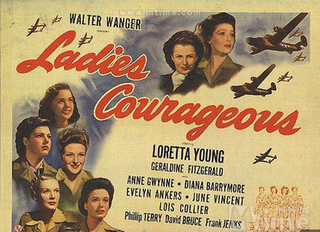
Ladies Courageous is a 1944 war film based on the novel Looking For Trouble (1941) by Virginia Spencer Cowles. Directed by John Rawlins, the film stars Loretta Young and Geraldine Fitzgerald. It tells the story of the paramilitary Women's Auxiliary Ferrying Squadron formed in the United States during World War II. Film historians and scholars consider Ladies Courageous an à-clef story of famed aviator Jacqueline Cochran and test pilot Nancy Harkness Love's work to mobilize women pilots to contribute to the war effort.

Women took on many different roles during World War II, including as combatants and workers on the home front. “More than six million women took wartime jobs in factories, three million volunteered with the Red Cross, and over 200,000 served in the military.” The war involved global conflict on an unprecedented scale; the absolute urgency of mobilizing the entire population made the expansion of the role of women inevitable, although the particular roles varied from country to country. Millions of women of various ages were injured or died as a result of the war. “When the war ended, a majority of women wanted to keep their jobs and their new-found economic and social independence, but nearly all were laid off, as orders for war materials decreased and millions of men returned home from military service seeking jobs.” Because the war took such a toll on the nation, many women were left trying to work though the men returned home.
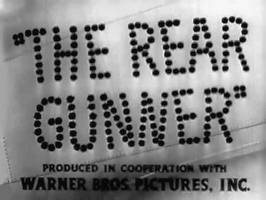
The Rear Gunner is a 1943 American short instructional film, directed by Ray Enright and produced by Warner Brothers. Previously, Warner Bros. had produced three short documentary films, Winning Your Wings (1942) starring Jimmy Stewart, Men Of The Sky (1942) and Beyond the Line of Duty (1942).

Men of the Sky is a 1942 American Technicolor short propaganda film, directed by B. Reeves Eason. The documentary film reenacted the training of a group of United States Army Air Forces (USAAF) pilots.
References
- ↑ Eliot 2006, p. 181.
- ↑ Biederman, Patricia Ward. "Winning the war, one frame at a time". Los Angeles Times, October 30, 2002. Retrieved September 7, 2008.
- ↑ "Preserved Projects". Academy Film Archive.